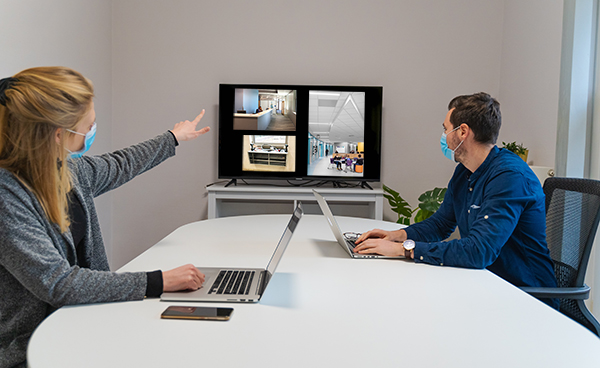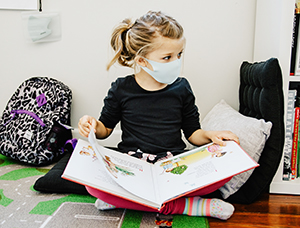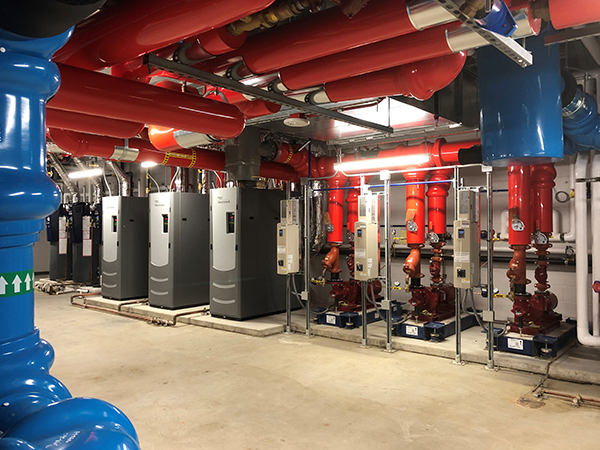
A once-in-a-generation opportunity: EDengage roundtable explores how school districts can spend ESSER III COVID relief funds for the greatest impact
What projects qualify for COVID relief? How can we use the funds to improve our dated ventilation systems? Will the funds cover remodeling? What about new construction?
These are just a few of the questions school administrators are asking as they scramble to find appropriate ways to spend their share of the U.S. Department of Education’s American Rescue Plan Elementary and Secondary School Emergency Relief (ARP ESSER) Fund enacted on March 11, 2021. The fund, also known as ESSER III, sets aside $122 billion to help school districts safely reopen given the COVID-19 pandemic’s impact, along with $3 billion for special education and $2.75 billion for non-public schools.
Schools can invest up to 80% of their ESSER III funds in facilities projects, provided that they align with Centers for Disease Control and Prevention (CDC) guidelines and help reduce transmission of COVID-19 and other viruses. Potential projects range from touchless technology installation and ventilation system improvements to controlled entry enhancements and classroom upgrades. The fund requires districts to provide spending documentation for their qualified projects by September 30, 2024. Districts can also get reimbursed for pre-award costs dating back to March 13, 2020. Most projects involving ESSER III funding will have 2022 start dates.
Each district must present its strategy for spending the COVID relief funds to a state agency. For instance, the Ohio Department of Education (ODE) requires all districts to fill out a standardized grant application and state how they want to use ESSER funds.
Districts are, however, experiencing some hiccups as they attempt to move forward with projects. Peg Agnos, executive director of LEND DuPage (Legislative Education Network of DuPage), said that some Illinois districts in her network have waited a long time to hear back on ESSER spending plans submitted to their regional offices. These same districts have had trouble connecting with the organizations to get status updates.
Considering the uncertainty and hurdles that many of our school districts clients have encountered, Legat Architects made COVID relief funding (ESSER III in particular) the topic of our most recent EDengage forum. The virtual roundtable brought together school leaders, attorneys, architects, and engineers from across the Midwest to explore funding questions and strategies.

The Best Spend Requires a Holistic Facilities Plan
Agnos refers to the ARP Act as “an astounding amount of funding to public education and a once-in-a-generation chance.” Consequently, such a rare opportunity creates a great deal of pressure on districts to spend their allotments wisely. And new information about the funds seems to come out every day.
Brian Bruggeman, chief client officer at Kentucky-based KLH Engineers, pointed out a conundrum that many larger school districts face when it comes to the ensuring the “best spend” for HVAC system upgrades (or any coronavirus-related improvement, for that matter): “If you’re a school district with x number of buildings and have so much need, where is the right spend to keep people healthy versus alienating people politically at a given facility? I empathize with districts facing this pressure.”
One way to ensure equitable spending of ESSER funds is to engage an architect/engineering team to conduct a comprehensive facilities analysis. The resulting report will identify need, recommend ESSER-qualifying enhancements, estimate costs, and create a master schedule. Such documentation will help districts navigate the political minefields when the time comes to explain to communities where and why dollars are being spent.
And while some districts may get involved in cooperative purchasing, dollars need to be tracked separately. “What it boils down to,” said Legat Architects’ President and CEO Patrick Brosnan, “is the need for districts to develop a holistic facilities plan so dollars can be tracked start to finish.”

Connect the Dots to Virus Transmission Prevention
One of the first questions that comes up regarding COVID relief is, “What exactly can I use these funds for?”
According to attorney Ken Florey, partner with Chicago-based Robbins Schwartz, any institution that seeks ESSER funding must be able to “connect the dots” between the project and the overall goal of the federal statute: to reduce the risk of virus transmission. Thus, if a district can prove that risk of spread goes down if students move into a renovated space, then that renovation is “fair game.”
Sean Lehman, attorney with Bricker & Eckler (Columbus, Ohio), said that compared to ESSER I and ESSER II, the legislation for ESSER III was drafted much more broadly, giving districts “a pretty wide door to walk [themselves] through.” When advising clients on whether their needs qualify, he breaks his analysis into three parts:
- Is the project in question an allowable expenditure?
- Are there any hurdles the institution might encounter in terms of compliance with state laws? He gives the example of Ohio state laws that require any district construction work over $50,000 to be competitively bid.
- How can the institution carry out the projects in accordance with federal law? For instance, districts in all states with projects above $250,000 must use sealed bids or a competitive proposal process. Thus, Ohio projects that comply with state guidelines automatically meet federal requirements.

The Many Paths to Better Indoor Air Quality
The majority of COVID relief work that Lehman has seen over the last couple of months involves HVAC-related projects aimed at improving indoor air quality (IAQ).
During the pandemic, RTM Engineering Consultants’ principal and mechanical engineer Kathryn Duytschaever, based in Davenport, Iowa, has seen IAQ projects ranging from updating operable windows and CO2 detection systems to installation of all-new building automation systems (BAS).
As more students return to schools, many districts have converted smaller spaces (e.g., storage rooms, offices) into classrooms to maintain social distancing. For example, Julio Valladares, treasurer and chief financial officer with Newark City Schools (Ohio), said his district had to turn some closets into classrooms to provide pre-K spaces. These sorts of conversions often require bringing proper ventilation into the smaller spaces—a project type that qualifies for the federal funding.
Alex Trevino, director of capital improvements at Columbus City Schools, said, “Everything I’m reading today says that the priority should be to use mechanical ventilation to dilute and bring in as much outdoor air as possible.”
Unfortunately, many school districts operate older buildings with limited or no air conditioning. These facilities are not ventilated to meet today’s codes. The ARP ESSER Fund creates an opportunity to connect these shortcomings with reducing virus spread, especially as districts consider extending learning into summer months.
Dr. Reginald Lawrence II, superintendent at Rock Island-Milan School District #41 (Illinois), sees the ESSER III funds as a blessing since most of the 14 facilities in his district are older, meaning their air handling systems are nearing the end of their 25-year expected lifespan. Thus, using the funds to replace dated equipment will help prepare his district for the next 25 years.

Other districts have turned to alternative technologies to help reduce virus transmission. Scott Gaunky, director of facilities with Lincolnshire-Prairie View School District 103 (Illinois), had ultraviolet (UV) disinfection systems installed in all his district’s rooftop units and air handlers. His team also installed individual medical air scrubber units in each classroom and every office.
Bruggeman pointed out another approach to achieving higher IAQ: installation of bipolar ionization systems, which his own son’s school did for about $26,000 inclusive of labor.
One participant asked about the possibility of ionization system installations causing increased ozone and therefore impacting occupants with asthma and other respiratory issues. Duytschaever said that modern bipolar ionizers that adhere to Underwriters Laboratories’ (UL) stringent guidelines put out such a low amount of ozone that it gets rapidly depleted without affecting occupants. Both she and Bruggeman advised districts to make sure their teams do the research to make sure high-quality, safe bipolar ionization systems are installed.
Do New Construction and Retrofits Qualify for COVID Relief Funds?
One EDengage participant wanted to know whether COVID relief funds would cover a retrofit that would transform an older, non-school facility into a preschool. Other educators asked about new construction. Given the broad strokes of the ARP ESSER Fund language, we consider the answer to both questions a cautious “yes.” Again, the district would have to show a correlation between the project and a drop in virus transmission.
Though attorney Lehman has not seen any major new construction projects stemming from ESSER funds, he thinks “it’s just a matter of time in Ohio before someone decides to be the first.”
Another EDengage participant asked why schools would need more space if social distancing gaps are returning to pre-COVID standards. The answer has to do with projected growth. For instance, many families in southern Illinois are jumping the boarder to live in Indiana, where schools that are already overcrowded will need to expand to ensure social distancing as they grow.

20% for Lost Learning
The ARP ESSER Fund dictates that at least 20% of the funds received must tackle lost learning time.
Lawrence considers himself an optimist. “Everybody keeps talking about learning loss, learning loss, learning loss,” he said, “but right now, our focus is on expanding learning opportunities.”
The most recent batch of MAP (Measure of Academic Progress) tests coming out of Lawrence’s district show that students are performing the same, if not better than how they performed last year. Accordingly, Lawrence said that the 20% portion of his district’s ESSER funds will go back into social-emotional learning.
According to Lawrence, districts that immediately return to “big-time academics” when students come back from quarantine are “missing the point.” He said, “I know there will be people who get back and jump into chapter 12, but you need to be building relationships and bringing in professional development for teachers. Kids need to get back to feeling good about themselves and being prepared to learn.”
Document, Document, Document
One of the most important pieces of advice that emerged from the EDengage session was to create thorough documentation of ESSER III spending. Lehman said, “The guidance we’ve received from the Ohio Auditor of State for all these ESSER funds is ‘document document document.’” He recommends at the very least having a file so when state auditors investigate, they can see the district’s thought process.
Brian Bruggeman cited the vagueness of the ARP ESSER guidelines to echo Lehman’s advice. “My gut tells me that somewhere down the line, the rules are going to expand,” he said. “Having that information documented—purpose of project, what is it serving, observations—is going to be important for everybody.”
For more information including a list of projects that potentially qualify for COVID relief funding, suggested steps to take, and national and state resources, explore our ESSER III COVID Relief Funding summaries for Illinois, Iowa, and Ohio.
Contact us to discuss COVID relief facilities planning or comment below to share your thoughts on this post.


